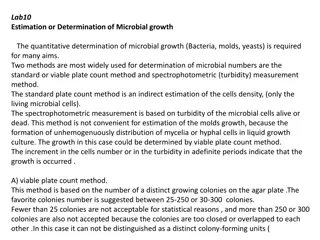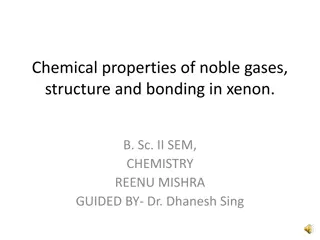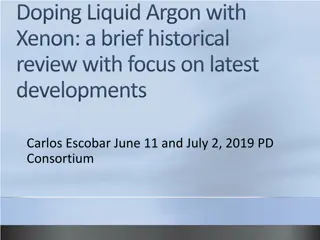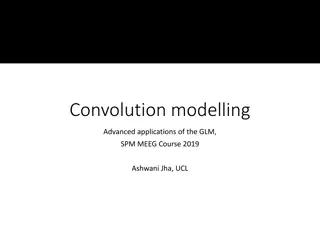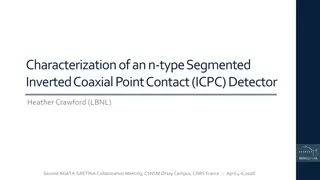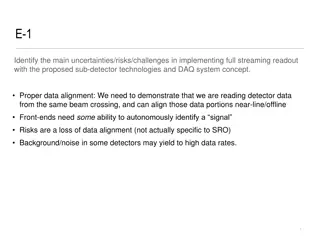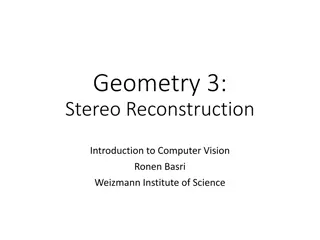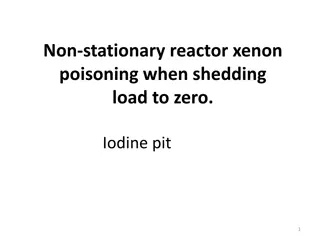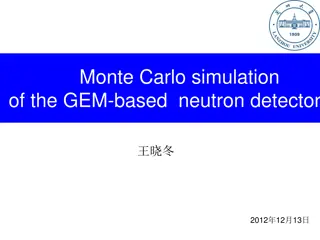Development of Event Reconstruction Method for MEG II Liquid Xenon Detector
Implementation of advanced techniques for enhancing the performance of the MEG II liquid xenon detector, including upgrades to photon collection efficiency, signal readout methods, and event reconstruction. The improvements, validated by MC simulations, demonstrate increased detection efficiency and precision in energy and position resolution. Detailed analyses of the upgraded LXe detector's performance and design optimizations are presented.
Download Presentation

Please find below an Image/Link to download the presentation.
The content on the website is provided AS IS for your information and personal use only. It may not be sold, licensed, or shared on other websites without obtaining consent from the author.If you encounter any issues during the download, it is possible that the publisher has removed the file from their server.
You are allowed to download the files provided on this website for personal or commercial use, subject to the condition that they are used lawfully. All files are the property of their respective owners.
The content on the website is provided AS IS for your information and personal use only. It may not be sold, licensed, or shared on other websites without obtaining consent from the author.
E N D
Presentation Transcript
1 MEG II Development of the event reconstruction method for MEG II liquid xenon detector @ @ 2015 MEG II MEG II 2015
2 Table of contents 1. Introduction of LXe detector in MEG II. 2. Performance of LXe detector 3. Signal readout method comparison 4. Effect from the uncertainty of PDE 5. Summary
3 Upgrade of LXe detector for MEG II Replace PMT of -entrance face to MPPC Photon collection efficiency becomes uniform MEG MEG II (CG) MEG 12 12 mm2 MPPC log scale 2 inch PMT Imaging power improves Change PMT alignment of lateral face Energy leak decreases MEG II MEG MEG II wider log scale
4 2. Performance of LXe detector
5 Performance estimation Performance improvement of LXe detector has already been confirmed by MC simulation. MEG UpgradeProposal (arXiv:1301.7225) 70 21pDK-6 Position resolution vs. depth Energy Distribution for signal Position resolution [mm] 8 MEG I:red MEG II:blue MEG I:red MEG II:blue 0.4 depth < 2cm 40% of events depth > 2cm 60% of events 0.5 7 0.35 6 0.4 0.3 5 E E 0.25 0.3 2.4% 1.1% 4 1.7% 1.0% 0.2 3 0.2 0.15 2 0.1 MEG I:red MEG II:blue 0.1 1 0.05 0 0 0 48 50 52 54 56 58 0 5 10 15 20 48 50 52 54 56 58 Conversion depth [cm] Energy [MeV] Energy [MeV] We carried out the performance estimation again. Finalized design of the detector Improved and optimized analysis
6 Detection efficiency Detection efficiency for signal -ray in the detector acceptance. Defined as the fraction of events whose energy deposit in LXe is over 48MeV Design of the material before entrance face has been finalized. Improvement by 9% is observed from MEG I. Thanks to the reduced amount of material in the entrance face, Consistent with rough estimation in previous study (69%). Material before entrance face (not to scale) ceramic MEG I MEG II quartz MPPC package (this study) 2.5mm silicon silicon ceramic Efficienc y 64.7% 70.4% spacer (FR4) Assembly PCB (FR4+Cu) 1.4mm Filled with LXe 1.6mm spacer (FR4+Cu) 1.4mm 9% improvement Support structure (CFRP) 7mm Cryostat wall
7 Event reconstruction Waveform simulation is performed for each MPPC and PMT. Based on the measured properties of MPPC, PMT. Crosstalk, after pulse, saturation of MPPC are simulated. Same noise level with MEG I is assumed. Timing and # of p.e. of each MPPC, PMT are obtained by analyzing simulated waveform. Same reconstruction algorithm with MEG I, optimized to MEG II. Position is reconstructed from the number of p.e. distribution on the entrance face. Energy is reconstructed from the summation of the photon for all channels, taking into account of different coverage for each channel. Timing is reconstructed by fitting the time of each channel, considering TOF and timewalk. waveform simulation waveform analysis MC simulation simulated waveform Hit position Energy Timing of -ray hit of scintillation photon Event # of p.e. timing 1p.e. waveform Reconstruction
8 Resolution of LXe detector Estimated resolution for MEG II LXe detector. Better resolution than previous estimation. Thanks to the analysis optimization Resolution MEG II (shown in last JPS) MEG II (this study) u/v/w (mm) 2.7/ 2.3/ 3.7 2.2/2.0/2.3 E (w<2cm) E (w>2cm) t (ps) 0.62% 0.65(4)% 0.53% 0.49(2)% 71 (preliminary) 56(1) Reconstructed E t(rec) - t(MC) v h0 Reconstructed Energy (w<2cm) Reconstructed Energy (2<w<40cm) Entries Entries 20902 20902 700 240 Entries Entries 19548 19548 6974 6974 Entries Entries 6.2 6.2 Constant Constant 642.5 642.5 v 200 u p0 p0 220 p0 p0 198.3 198.3 4.4 4.4 5.4 5.4 217.7 217.7 - - - - 600 Mean Mean 1.802e 1.802e 12 12 4.727e 4.727e 13 13 w 180 u p1 p1 p1 p1 52.9 52.9 0.0 0.0 0.02 0.02 52.92 52.92 200 Sigma Sigma - - - - 5.64e 5.64e 11 11 4.63e 4.63e 13 13 w p2 p2 0.3481 0.3481 0.0194 0.0194 160 p2 p2 0.0133 0.0133 0.2512 0.2512 180 500 p3 p3 - - 0.117 0.117 0.019 0.019 p3 p3 0.01238 0.01238 - - 0.08062 0.08062 140 160 depth<2cm depth>2cm 400 140 120 120 100 300 100 80 80 200 60 60 40 40 100 20 20 - 9 10 ns 0 0 0 0.6 - 0.4 - 0.2 - 0 0.2 0.4 0.6 49 50 51 52 53 54 55 49 50 51 52 Energy (MeV) 53 54 55 Energy(MeV) Energy(MeV) Energy (MeV)
9 3. Signal readout method comparison
10 Signal readout method comparison Series connection of MPPC will be used. To avoid the long time constant caused by the large area MPPC. Two candidates for signal readout method 2p2s (2parallel 2series) connection 4s (4series) connection Performance of the detector can be affected. Different S/N ratio can affect position, energy, and timing resolution Different time constant of waveform can affect timing resolution and pileup. 12mm @7V over voltage 2p2s connection 4s connection 1.6 106 0.8 106 gain leading time 6.5ns 2ns Four independent MPPC chip on one package 2p2s 4s trailing time Definition of time constant: [0]*(exp(-t/leading_time) - exp(-t/trainling_time)) 49ns 33ns connection connection
11 Signal readout method comparison Two kinds of noise level are assumed. MEG I noise level, higher noise level. Same resolution for position and energy. Better timing resolution for 4s connection even under higher noise condition. We decided to use 4s connection. MEG I noise level (0.3mV) 4s connection 2p2s connection Higher noise level (1.0mV) 4s connection 2p2s connection u/v/w (mm) 2.4/2.2/3.1 2.4/2.2/3.1 u/v/w (mm) 2.4/2.2/3.1 2.4/2.2/3.1 E ( of upper Edge) 0.67(2)% 0.68(2)% E ( of upper Edge) 0.74(3)% 0.79(3)% t (ps) 60(1) 69(2) t (ps) 70(2) 75(2) These resolutions are estimated before analysis improvement.
12 4. Effect from the uncertainty of PDE
13 Uncertainty of PDE There is the uncertainty of PDE of MPPC. Absolute PDE of MPPC is not well-known. Broad distribution of PDE is observed in mass test. We may not be able to measure the PDE correctly for each MPPC in the final detector. PDE may have an angular dependence which is not consistent with the expectation from the reflection at silicon surface. Effects of these uncertainty to the detector performance are estimated. MC truth of #of p.e. and timing for each MPPC,PMT are used for simplicity. PDE vs. over voltage 17-27% @6.5V over voltage h0 PDE vs. incident angle PDE distribution measured in mass test py py 4 Entries Entries 31 31 3.5 Mean Mean 0.1522 0.1522 RMS RMS 0.009134 0.009134 3 0.0020 0.0020 Constant Constant 1.866 1.866 0.451 0.451 Mean Mean 0.1526 0.1526 2.5 Sigma Sigma 0.009807 0.009807 0.001712 0.001712 2 Broad distribution 1.5 angular dependence 1 0.5 0 0.04 0.06 0.08 0.1 0.12 0.14 0.16 0.18 0.2 incident angle (deg)
14 Effect of absolute PDE Position resolution Graph Absolute PDE can be smaller than our previous assumption. We checked the degradation of resolution through statistical contribution at smaller PDE. We observed the degradation of resolution at very small PDE, but effect seems negligible in the range of our measured PDE. Position Resolution (mm) 3 2.5 2 1.5 red:u blue:v green:w 1 0.5 measured PDE 0 0 5 10 15 20 25 30 35 MPPC PDE (%) Energy resolution Graph Timing resolution Graph Energy Resolution (%) 0.8 70 Timing Resolution (ps) 0.75 60 0.7 50 0.65 0.6 40 0.55 30 0.5 Red:all depth Green:depth<2cm Blue:depth>2cm 20 0.45 0.4 10 measured PDE measured PDE 0.35 0 5 10 15 20 25 30 0 5 10 15 20 25 30 35 MPPC PDE (%) PDE (%) Reconstructed from MC truth of # of p.e. and timing. Resolution from waveform analysis result is 55ps @ PDE 22%.
15 Effect of PDE ratio b/w MPPC and PMT We will use two kinds of sensors, MPPC and PMT. We have to estimate the ratio between PDE of MPPC and QE of PMT correctly for the energy reconstruction. Energy is the summation of the number of the photon, and PDE (QE) is used for converting # of p.e. to # of photons. Event by event fluctuation of the ratio of # of p.e. detected in MPPC and PMT can cause the degradation of energy resolution, if our assumption of the PDE ratio is wrong. Energy resolution by assuming several PDE for MPPC Graph 2.5 Resolution becomes worse if assumed relative PDE ratio is wrong. We can estimate the true ratio by scanning assumed PDE in the analysis and finding the PDE at which energy resolution becomes best. Energy Resolution (%) true PDE:22% Red:all depth Blue:depth>2cm Green:depth<2cm 2 1.5 1 0.5 0 0.4 0.6 0.8 (Assumed PDE ratio)/ (True PDE ratio) 1 1.2 1.4 1.6 1.8 2 (Assumed PDE)/ (True PDE)
16 Effect of PDE estimation error Broad distribution of PDE is observed in the mass test of MPPC. PDE(QE) of each MPPC(PMT) will be estimated by using alpha source in the final detector. Error of PDE(QE) estimation can cause the degradation of resolution. Effect from this error to the detector resolution is estimated. Error of both PMT and MPPC are taken into account. Currently observed distribution is the upper limit of the estimation error. Events are simulated with PDE variation and reconstructed by assuming constant PDE. PDE measured in mass test (at small incident angle ) QE measured in MEG I h0 h0 py py 4 MPPC PMT h0 h0 40 Entries Entries 31 31 Entries Mean RMS Constant Mean Sigma Sigma Entries Mean RMS Constant Mean 846 846 3.5 0.1566 0.03337 37.4 0.0010 0.1593 0.00093 0.02676 0.02676 0.1566 0.03337 37.4 0.1593 Mean Mean 0.1522 0.1522 35 RMS RMS 0.009134 0.009134 3 1.7 1.7 0.0010 0.00093 30 0.0020 0.0020 Constant Constant 1.866 1.866 0.451 0.451 Mean Mean 0.1526 0.1526 2.5 25 Sigma Sigma relative sigma:6.5% 0.009807 0.009807 0.001712 0.001712 2 relative sigma:16% 20 1.5 15 1 10 0.5 5 0 0 0.04 0.06 0.08 0.1 0.12 0.14 0.16 0.18 0.2 0 0.05 0.1 0.15 0.2 0.25 0.3
17 Effect of PDE estimation error We compared three cases. case A: no estimation error for both MPPC and PMT case B: no estimation error for MPPC, 16% estimation error for PMT case C: 6.5% estimation error for MPPC, 16% estimation error for PMT Degradation of the resolution is observed for the energy resolution. Correct estimation of PDE seems important. Energy resolution Graph Energy Resolution (%) 1.4 Red:all depth Blue:depth>2cm Green:depth<2cm Resolution case A case B case C 1.2 u/v/w (mm) 2.2/2.0/2. 2.2/2.0/2. 3 2.6/2.4/2.6 1 3 0.8 E ( of upper Edge) 0.57(1)% 0.71(2)% 0.78(2)% 0.6 0.4 0.2 case A case B case C t (ps) Reconstructed from MC truth of # of p.e. and timing. Resolution from waveform analysis result is 55ps @ PDE 22%. 39(1) 38(1) 40(1) 0
18 Effect of angular dependence of PDE angular dependence of PDE Effect of the angular dependence of PDE is estimated. Angular dependence observed in the mass test is assumed in the simulation. Information of angular dependence is not used in the reconstruction. Angular dependence changes the p.e. distribution on the inner face, and reconstructed depth is shifted to shallower. Shift is 3-20mm depending on the depth depth(rec) -depth(MC) (2cm<depth<4cm) Graph PDE p0 p0 0.1495 0.1495 0.003009 0.003009 p1 p1 0.18 21.45 21.45 2.853 2.853 p2 p2 - - 05 - 05 - - - 6.166e 6.166e 1.047e 1.047e 05 05 0.16 0.14 0.12 0.1 0.08 0.06 10 20 30 40 50 incident angle (deg) Shift of reconstructed depth vs. depth w(rec) - w(MC) ( 2.0 <w < 4.0) Graph 20 400 Shift of w (mm) 4818 0.4305 0.4305 4818 Entries Mean RMS 0.3645 RMS 0.3645 Entries Mean 18 350 - - 16 300 reconstructed depth becomes smaller 14 250 12 10 200 8 150 6 100 4 50 2 0 0 0 2 4 6 8 10 12 14 16 18 20 cm - - - 3 2 1 0 1 2 3 Reconstructed w (depth) (cm)
19 Effect of angular dependence of PDE Sum of # of p.e. (all MPPCs) blue: w/o angular dependence red: w/ angular dependence Position resolution Small degradation for depth Sum of # of p.e. (all MPPCs) 1400 25% decrease 1200 Timing resolution Little effect to timing resolution 1000 800 600 400 Energy resolution Decrease of the # of p.e. can be recovered by weighting # of p.e. detected on MPPC. Same energy resolution can be obtained even with angular dependence. 200 3 10 0 0 20 40 60 80 100 120 140 Sum of # of p.e. Resolution w/o angular dependence w/ angular dependence u/v/w (mm) 2.2/2.0/2.3 2.2/2.0/2.7 E ( of upper Edge) 0.57(1)% 0.58(2)% t (ps) 39(1) 41(1) Reconstructed from MC truth of # of p.e. and timing. Resolution from waveform analysis result is 55ps @ PDE 22%.
20 How to deal with uncertainty of PDE Effect of absolute PDE Little effect to performance. Effect of relative PDE ratio btw/ MPPC and PMT Relative PDE ratio is important for energy reconstruction. Can be estimated in the calibration run. Effect of PDE estimation error Effect to the energy is not negligible. PDE (QE) estimation for each MPPC and PMT is important. Effect of angular dependence of PDE Reconstructed depth is shifted. If we can know the angular dependence, this shift can be corrected. A new measurement of angular dependenceis being planned (see 27aSN-9). Method to know the angular dependence in the final detector will be studied.
21 Summary Performance of MEG II LXe detector are estimated with realistic settings together with the several improvement and optimization of analysis. For signal readout, 4s connection will be used as it has better timing resolution. Effects from the uncertainty of PDE are estimated. Some of them are not negligible (especially shift of depth by angular dependence). How to decrease these effects are being studied. We are planning another measurement to further investigate the PDE variation and angular dependence. MEG I MEG II MEG II (this study) (in last JPS) efficiency 64.7% not estimated 70.4% u/v/w (mm) 5/5/6 2.7/2.3/3.7 2.2/2.0/2.3 0.7% contribution are assumed for MEG II (from unsolved difference between MC and real detector in MEG I) E (depth<2cm) 2.4% 0.9% 0.9% E (depth>2cm) 1.7% 0.9% 0.8% t (ps) 67 71 56
22 Backup
23 abstract MEG MEG II !LaTeX$\mu \rightarrow e \gamma$ MEG II 4000 MPPC
24 Layout of PMT on top/bottom face Energy resolution vs. v Graph We observed that events near top/bottom face show worse energy resolution than other events. We tried to improve this, by modifying the layout of PMT on top/bottom face. Number of PMT increases from 54 to 73 for each face. PMT is placed staggered to improve photon collection uniformity. Improvement of energy resolution near top/bottom can be seen. (though it is not so clear) 1000 Energy resolution (keV) 900 black: old layout red:new layout 800 700 600 500 400 300 200 fiducial volume 100 0 45 50 55 60 65 v (cm) Current MC geometry Old Layout New Layout
25 Detection Efficiency Efficiency(%) MEG I MEG II 67.9 61.5 1.4 region 1 55.9 65 59 60.3 1.8 region 2 55.0 70.6 1.2 region 3 61.7 62.3 1.0 region 4 56.3 69.0 0.6 region 5 63.8 9 15 20.9 3 23.9 71.9 0.6 region 6 66.5 73.5 0.6 region 7 67.1 h2d10 v(cm) 72.9 0.8 region 8 67.9 70 0.75 fiducial volume Averaged with area 64.2 70.0 60 0.7 50 0.65 Averaged with MEG I weight 64.7 70.4 40 0.6 30 0.55 20 0.5 10 0.45 0 0 5 10 15 20 25 u(cm) fiducial volume
26 Setting for MC PDE Gain Crosstalk Prob. Afterpulse Prob. Event by event fit 2p2s 4s trailing time const. 49ns 33ns 22 % 0.8 106 15% 15% leading time const. 6.5ns <2ns 22% PDE PDE vs. over voltage Gain vs Over Voltage Crosstalk Probability vs Over Voltage 3 10 2000 Crosstalk Probability Gain 0.5 15% Crosstalk Prob. 1800 0.8M Gain 1600 0.4 1400 0.3 1200 1000 0.2 800 17-27% @6.5V over voltage 0.1 600 400 0 200 0 -0.1 2 4 6 0 2 4 6 8 Over Voltage (V) Over Voltage (V) measured waveform of 1p.e. measured waveform of 1p.e. 4s 2p2s
27 Waveform analysis In waveform analysis, charge (# of p.e.) and timing are calculated. Charge is calculated from fixed integration range. Constant fraction method is used for timing calculation (with 10% of pulse height threshold) Waveform Waveform simulated waveform constant fraction time 0 pulse height * 0.10 -0.05 -0.1 -0.15 -0.2 integration range 200ns -0.25 -6 10 -0.6 -0.5 -0.4 -0.3 -0.2
28 Waveform analysis for over range channel As PDE and gain increases, 35% of event have at least one channel in which pulse height becomes higher than dynamic range of waveform digitizer (950mV). We can avoid over range by decreasing amp gain but it leads to worse SN ratio, and it may result in worse resolution. (Quantitative estimation has not done yet.) However, appropriate waveform analysis to these over range channel is important for reconstruction as they have large # of p.e. Number of over range channel Number of over range channel per event pulse height vs #ofp.e.(MC) Pulse height vs #ofp.e. h100 h100 1 pulse height (V) Entries Mean Entries Mean RMS RMS 8028 1.092 1.756 1.756 8028 1.092 5000 0.9 0.8 4000 0.7 some channels become over range 0.6 3000 35% event have over range channel 0.5 0.4 2000 0.3 0.2 black:MPPC red:PMT 1000 0.1 0 0 0 1 2 3 4 5 6 7 8 9 10 0 2000 4000 6000 8000 10000 # of p.e.
29 Waveform analysis for over range channel For these over range channel, TOT (Time Over Threshold) method are used for charge calculation in MEG I. Same method can be used for MEG II. Charge vs TOT(Time Over Threshold) Charge 0 -5 -10 -15 Relation between TOT and charge are calculated beforehand. In this study, over range channels are not used for timing calculation. -20 -25 -30 -35 -6 10 0 0.05 0.1 0.15 0.2 0.25 TOT(s) (#of p.e. from wf analysis) /(#of p.e. of MC truth) simulated waveform (over range ch) Waveform Waveform 90 TOT 0 80 0.2% rms 150mV 70 4% rms -0.2 60 DRS dynamic range -0.4 50 Red:Over Range channel (Npe>5000) Blue:Normal channel (Npe~4000) 40 -0.6 30 20 -0.8 10 -1 -6 10 0 -0.6 -0.5 -0.4 -0.3 -0.2 0.75 0.8 0.85 0.9 0.95 1 1.05 1.1 1.15 1.2 1.25
30 Position reconstruction Position is reconstructed by fitting # of p.e. distribution of inner face with the solid angle from conversion point to each MPPCs. Correction of shower direction is applied. We estimated position resolution by comparing with MC truth. u(rec)-u(MC) in cm (1<w<2cm) v h11 h11 u Entries Mean -0.004571 RMS RMS Entries Mean -0.004571 1146 1146 100 v w 0.4074 0.4074 u 80 w 60 40 20 0 -5 -4 -3 -2 -1 0 1 2 3 4 5 cm
31 Global Correction Global correction for U is coming from average shower direction. Shower direction is not perpendicular to inner face in UR space. This is not the case for V, as inner face is perpendicular to in VR space. Global correction for W is basically a offset depending on FitRange. UR space
32 Global Correction with FitRange[0] 16 MPPC U,W is corrected as a function of U,W u(rec)-u(MC) v(rec)-v(MC) w(rec)-w(MC) Uresidual vs U Vresidual vs V Wresidual vs W h2d0300 Entries Mean x 0.1807 Mean y - RMS x RMS y RMS y h2d0300 Entries Mean x 0.1807 Mean y - RMS x h2d0301 Entries Mean x 0.01521 - Mean y 0.001122 RMS x h2d0301 Entries Mean x 0.01521 - Mean y 0.001122 RMS x RMS y RMS y h2d0302 Entries Mean x Mean y 1.395 RMS x h2d0302 Entries Mean x Mean y 1.395 RMS x RMS y 0.9585 RMS y 0.9585 5 5 5 90 35 22169 22169 22169 22169 22169 6.21 6.21 22169 40 4 4 4 80 0.0013 15.72 0.7818 0.7818 0.0013 15.72 30 39.59 0.6174 0.6174 39.59 4.124 4.124 3 3 3 35 70 2 2 2 25 30 60 1 1 1 25 20 50 0 0 0 20 40 15 - - - 1 1 1 15 30 - - - 2 2 2 10 10 20 - - - 3 3 3 5 5 10 - - - 4 4 4 - - - 5 0 5 0 5 0 40 - 30 - 20 - 10 - 60 - 40 - 20 - 0 10 20 30 40 u(rec) 0 20 40 60 0 2 4 6 8 10 12 14 16 18 20 v(rec) w(rec) average shower direction Fitted value of par[1]=Mean Fitted value of par[1]=Mean Fitted value of par[1]=Mean h2d0300_1 Entries Mean h2d0300_1 Entries Mean RMS RMS h2d0301_1 Entries Mean RMS RMS h2d0301_1 Entries Mean h2d0302_1 Entries Mean h2d0302_1 Entries Mean RMS RMS 3 3 3 88 88 96 96 101 101 - - - - 768.6 768 768 768.6 51.64 46.84 46.84 51.64 5.882 5.882 6.37 6.37 2 2 2 offset 1 1 1 0 0 0 - - - 1 1 1 - - - 2 2 2 - - - 3 3 3 40 - 30 - 20 - 10 - 60 - 40 - 20 - 0 10 20 30 40 0 20 40 60 0 2 4 6 8 10 12 14 16 18 20 Uresidual Vresidual Wresidual h0300 h0300 h0301 h0301 h0302 h0302 Entries Mean 0.001088 - Entries Mean 0.001088 - RMS RMS 22169 22169 Entries Mean 0.001122 RMS RMS Entries Mean 0.001122 22169 22169 Entries Mean Entries Mean RMS RMS 22169 1.39 22169 1.39 0.988 0.988 2200 1800 1400 2000 0.7824 0.7824 0.6174 0.6174 1600 1800 1200 1400 1600 1000 1400 1200 1200 800 1000 1000 800 600 800 600 600 400 400 400 200 200 200 v(rec) 0 5 u(rec) 0 0 w(rec) - - - - - - - - - - - - - - - 5 4 3 2 1 0 1 2 3 4 5 4 3 2 1 0 1 2 3 4 5 5 4 3 2 1 0 1 2 3 4 5
33 Shower Correction Correction of event by event fluctuation of shower direction. If we use wider fit range, the effect from shower direction increases. Information of shower direction can be derived from difference of the fit result using different fit range. This correction is applied for UV. Dependence can be seen also for W, it is also corrected.
34 Shower Correction U y axis: u(rec,iRegion) - u(MC) x axis: u(rec,iRegion+1) - u(rec,iRegion) iRegion=3 U before correction iRegion=0 iRegion=2 iRegion=1 iRegion=4 h2d0000 h2d0100 h2d0200 h2d0300 h2d0400 h2d0000 h2d0000 h2d0100 h2d0100 h2d0200 h2d0200 h2d0300 h2d0300 h2d0400 h2d0400 60 1 1 1 1 1 45 Entries Entries 22169 22169 Entries Entries 22169 22169 Entries Entries 22169 22169 Entries Entries 22169 22169 Entries Entries 22169 22169 14 50 Mean x 0.0002325 - Mean x 0.0002325 - Mean x 0.0005095 - Mean x 0.0005095 - Mean x 0.0009666 - Mean x 0.0009666 - Mean x 0.0003858 - Mean x 0.0003858 - Mean x 0.0002638 - Mean x 0.0002638 - 50 0.8 0.8 0.8 0.8 0.8 40 Mean y 0.001487 - Mean y 0.001487 - Mean y 0.001551 - Mean y 0.001551 - Mean y 0.0003471 - Mean y 0.0003471 - Mean y 0.0005618 - Mean y 0.0005618 - Mean y 0.002219 - Mean y 0.002219 - 50 RMS x RMS x 0.0732 0.0732 RMS x 0.07334 RMS x 0.07334 RMS x 0.06163 RMS x 0.06163 RMS x 0.06384 RMS x 0.06384 RMS x 0.03067 RMS x 0.03067 0.6 0.6 0.6 0.6 0.6 12 RMS y RMS y 0.3089 0.3089 RMS y RMS y 0.3362 0.3362 RMS y RMS y 0.3719 0.3719 RMS y RMS y 0.3909 0.3909 RMS y RMS y 0.4195 0.4195 35 40 40 0.4 0.4 0.4 0.4 0.4 40 10 30 0.2 0.2 0.2 0.2 0.2 30 30 25 80 0 0 0 0 30 0 20 - - - - - 0.2 0.2 0.2 0.2 0.2 60 20 20 20 15 - - - - - 0.4 0.4 0.4 0.4 0.4 40 10 - - - - - 0.6 0.6 0.6 0.6 0.6 10 10 10 20 5 - - - - - 0.8 0.8 0.8 0.8 0.8 0 0 0 0 0 - - - - - 1 1 1 1 1 0.2 - 0.15 - 0.1 - 0.05 - 0.2 - 0.15 - 0.1 - 0.05 - 0.2 - 0.15 - 0.1 - 0.05 - 0.2 - 0.15 - 0.1 - 0.05 - 0.2 - 0.15 - 0.1 - 0.05 - 0 0.05 0.1 0.15 0.2 0 0.05 0.1 0.15 0.2 0 0.05 0.1 0.15 0.2 0 0.05 0.1 0.15 0.2 0 0.05 0.1 0.15 0.2 Fitted value of par[1]=Mean Fitted value of par[1]=Mean Fitted value of par[1]=Mean Fitted value of par[1]=Mean Fitted value of par[1]=Mean h2d0000_1 h2d0000_1 h2d0100_1 h2d0100_1 h2d0200_1 h2d0200_1 h2d0300_1 h2d0300_1 h2d0400_1 h2d0400_1 1 1 1 1 1 Entries Entries 52 52 Entries Entries 52 52 Entries Entries 52 52 Entries Entries 52 52 Entries Entries 52 52 Mean 0.06942 - Mean 0.06942 - Mean 0.6838 - Mean 0.6838 - Mean 0.5255 Mean 0.5255 Mean 0.6762 Mean 0.6762 Mean 0.1463 Mean 0.1463 0.8 0.8 0.8 0.8 0.8 RMS 0.182 RMS 0.182 RMS 0.4923 RMS 0.4923 RMS 0.6536 RMS 0.6536 RMS 0.647 RMS 0.647 RMS 0.08312 RMS 0.08312 0.6 0.6 0.6 0.6 0.6 0.4 0.4 0.4 0.4 0.4 0.2 0.2 0.2 0.2 0.2 0 0 0 0 0 - - - - - 0.2 0.2 0.2 0.2 0.2 - - - - - 0.4 0.4 0.4 0.4 0.4 - - - - - 0.6 0.6 0.6 0.6 0.6 - - - - - 0.8 0.8 0.8 0.8 0.8 - - - - - 1 1 1 1 1 0.2 - 0.15 - 0.1 - 0.05 - 0.2 - 0.15 - 0.1 - 0.05 - 0.2 - 0.15 - 0.1 - 0.05 - 0.2 - 0.15 - 0.1 - 0.05 - 0.2 - 0.15 - 0.1 - 0.05 - 0 0.05 0.1 0.15 0.2 0 0.05 0.1 0.15 0.2 0 0.05 0.1 0.15 0.2 0 0.05 0.1 0.15 0.2 0 0.05 0.1 0.15 0.2
35 W threshold optimization Wthreshold[6] is decided from resolution for each fitting range. with Global correction, and Shower correction Fitted value of par[2]=Sigma Resolution of U vs W Fitted value of par[2]=Sigma Resolution of V vs W Fitted value of par[2]=Sigma Resolution of W vs W h2d2010_2 h2d2011_2 h2d2012_2 2 2 2 Entries 32 Entries 32 Entries 26 1.8 1.8 1.8 Mean 24.15 Mean 23.41 Mean 18.8 RMS 5.294 RMS 5.448 RMS 4.221 1.6 1.6 1.6 1.4 1.4 1.4 1.2 1.2 1.2 1 1 1 0.8 0.8 0.8 0.6 0.6 0.6 0.4 0.4 0.4 0.2 0.2 0.2 0 0 0 0 5 10 15 20 25 30 0 5 10 15 20 25 30 0 5 10 15 20 25 30 Wthreshold[6]={3,5,9,14,14,40}
36 Energy reconstruction Energy is reconstructed by the summation of the number of photon (not photoelectron) from all channels taking into account of different coverage for each channel. Correction as a function of position is applied. relative weight between MPPC & PMT # of p.e. (PMT,MPPC) # of photon (PMT,MPPC) factor (coverage around sensor) 1/PDE Correction of crosstalk & after pulse Conversion factor to energy MC truth or waveform analysis Reconstructed Energy w/o position correction Correction as a function of u,v,w Reconstructed Energy
37 Timing reconstruction Timing is reconstructed by fitting the time at each sensor, taking into account of TOF from the reconstructed conversion point. Error of the timing is a function of # of p.e. Calibrations of timewalk effect and calibration with position are done. 10 Error of timing as a function #ofp.e. PMT black: MCtruth red: waveform analysis 10 Error of timing as a function #ofp.e. MPPC black: MCtruth red: waveform analysis - 9 - 9 2.5 ns ns 2.5 2 2 1.5 1.5 1 1 0.5 0.5 0 0 0 0.02 0.04 0.06 0.08 0.1 0.12 1/sqrt(#ofp.e.) 0.14 0 0.02 0.04 0.06 0.08 0.1 0.12 1/sqrt(#ofp.e.) 0.14
38 Position resolution Improvement of position resolution for shallow event from MEG I can be seen as we expected in proposal. U resolution vs W V resolution vs W W resolution vs W 10 10 10 w resolution (mm) v resolution (mm) u resolution (mm) black: MC truth red: waveform analysis 9 9 9 8 8 8 7 7 7 6 6 6 5 5 5 4 4 4 3 3 3 2 2 2 1 1 1 0 0 0 0 2 4 6 8 10 12 14 16 18 20 22 0 2 4 6 8 10 12 14 16 18 20 22 0 2 4 6 8 10 12 14 16 18 20 22 reco.w (cm) reco.w (cm) reco.w (cm)
39 Energy resolution vs position Energy resolution vs U 600 Same resolution for all position with MC truth. Energy resolution (keV) 500 400 300 200 100 0 0 5 10 15 20 25 reco.u (cm) Energy resolution vs V Energy resolution vs W 600 600 Energy resolution (keV) Energy resolution (keV) blue:Waveform simulation red:MCtruth w/o CTAP,saturation 500 500 400 400 300 300 200 200 100 100 0 0 0 10 20 30 40 50 60 70 0 2 4 6 8 10 12 14 16 18 20 reco.v (cm) reco.w (cm)
40 Timing resolution vs. position Timing resolution vs U 70 Timing resolution (ps) 60 50 40 30 20 10 0 0 5 10 15 20 25 reco.u (cm) Timing resolution vs V Timing resolution vs W 70 Timing resolution (ps) Timing resolution (ps) 100 60 80 50 40 60 30 40 20 blue:Waveform simulation red:MCtruth w/o CTAP,saturation 20 10 0 0 0 10 20 30 40 50 60 70 0 2 4 6 8 10 12 14 16 18 reco.v (cm) reco.w (cm)
41 Comparison with reconstruction from MCtruth We also tried reconstruction using MCtruth of # of p.e. and timing for each MPPC,PMT for comparison. Effect from crosstalk, after pulse, saturation, noise can be seen. Almost same resolution is obtained for position and energy. Different timing resolution is observed. This can be coming from the error of timing in the waveform analysis. There is the room for the improvement in the waveform analysis. 10 Error of timing as a function #ofp.e. MPPC black: MCtruth red: waveform analysis - 9 2.5 2 1.5 1 0.5 0 0 0.02 0.04 0.06 0.08 0.1 1/sqrt(#ofp.e.) 0.12 0.14 Error of timing as a function #ofp.e. - 9 10 2.5 PMT black: MCtruth red: waveform analysis 2 Resolution MC truth waveform analysis 1.5 1 u/v/w (mm) 2.2/2.0/2.3 2.3/2.0/2.4 0.5 E (w<2cm) E (w>2cm) t (ps) 0.70(4)% 0.65(4)% 0 0 0.02 0.04 0.06 0.08 0.1 0.12 0.14 0.45(2)% 0.49(2)% 1/sqrt(#ofp.e.) 39(1) 56(1)
42 Wrong PDE ratio b/w MPPC and PMT reco.E vs reco.w wrong ratio changes reco.E vs. w This change can be calibrated in the calibration run h2d12 h2d12 60 25 Energy (MeV) Entries Mean x Mean y RMS x Entries Mean x Mean y RMS x RMS y RMS y 34246 4.689 51.74 4.549 1.833 1.833 34246 4.689 51.74 4.549 assumed PDE/true PDE=1.1 58 20 56 54 15 52 10 50 48 5 46 0 0 5 10 15 20 25 30 w (cm) reco.E vs reco.w reco.E vs reco.w h2d12 h2d12 h2d12 h2d12 60 18 60 Energy (MeV) Energy (MeV) Entries Mean x Mean y RMS x Entries Mean x Mean y RMS x RMS y RMS y 34246 4.76 52.91 4.648 34246 4.76 52.91 4.648 2.473 2.473 Entries Mean x Mean y RMS x Entries Mean x Mean y RMS x RMS y RMS y 34186 4.245 50.26 3.96 34186 4.245 50.26 3.96 2.103 2.103 16 assumed PDE/true PDE=2.0 16 58 58 14 14 56 56 12 12 54 54 10 10 8 52 52 8 6 50 6 50 4 4 48 48 2 assumed PDE/true PDE=0.6 2 46 46 0 0 0 5 10 15 20 25 30 0 5 10 15 20 25 30 w (cm) w (cm)
43 Wrong PDE ratio b/w MPPC and PMT h100 Entries Entries 114 114 60 Event by event fluctuation of detected # of p.e. for MPPC and PMT causes degradation of resolution with wrong PDE ratio. 58 assumed PDE/true PDE=1.0 56 54 52 50 x-axis: # of p.e.(MPPC) / # of p.e. (PMT) taking into account different coverage y-axis: reconstructed Energy selecting events in abs(u)<5 && abs(v)<15 && 3<w<4 48 46 0.2 0.3 0.4 0.5 0.6 0.7 0.8 0.9 1 h100 h100 Entries Entries 114 114 Entries Entries 114 114 60 60 assumed PDE/true PDE=0.5 assumed PDE/true PDE=2.0 58 58 56 56 54 54 52 52 50 50 48 48 46 46 0.2 0.3 0.4 0.5 0.6 0.7 0.8 0.9 1 0.2 0.3 0.4 0.5 0.6 0.7 0.8 0.9 1
44 Reproducibility of PDE fluctuation Case C(PMT QE distribution 16% + MPPC PDE distribution 6.5%) Reproducibility of the result is confirmed with different seed value. Graph 1.2 Energy Resolution (%) 1 0.8 0.6 Energy resolution red: all depth green:depht< 2cm blue: depth> 2cm 0.4 0.2 0
45 angular dependence trans_tot AngleDependenceOfPDE 0.6 1 0.5 0.8 0.4 0.6 0.3 LXe -> Si blue: s wave green: p wave red: average 0.4 0.2 0.2 0.1 0 0 10 20 30 40 50 60 70 80 90 0 0 10 20 30 40 50 60 70 80 90 incident angle (deg) incident angle (deg) red: angular dependence measured in mass test blue: angular dependence measured in mass test (w/o LXe to Si reflection) calculated from complex refractive index LXe: 1.61 Si: 0.8+2.2i
46 Additional angular dependence meas. We plan to do two different type of tests. Large chamber Small chamber Liquid Xe gas Xe 70cm ~20 MPPCs on moving stage MPPC (4 chips) Quick setup, only 4 chips Confirm angular dependence Movable stage, 20~30 MPPCs. Check the angular dependence and MPPC by MPPC variation of PDE Today s topic
Energy reconstruction (w/ angular dependence)47 Graph Sum of # of p.e. (all MPPCs) blue: w/o angular dependence red: w/ angular dependence 2 Energy Resolution (%) 1.8 Sum of # of p.e. (all MPPCs) 1.6 1400 25% decrease 1.4 1200 1.2 1000 1 800 0.8 600 0.6 400 0.4 200 0.2 3 10 0 0 0 20 40 60 80 100 120 140 0.3 0.4 0.5 0.6 0.7 0.8 0.9 1 Sum of # of p.e. (Assumed PDE)/ (True PDE) Reconstructed Energy (w<2cm) Reconstructed Energy (2<w<40cm) 240 Entries Entries 19548 19548 6974 6974 Entries Entries 200 p0 p0 220 198.3 198.3 4.4 4.4 p0 p0 5.4 5.4 217.7 217.7 180 p1 p1 p1 p1 52.9 52.9 0.0 0.0 0.02 0.02 52.92 52.92 200 p2 p2 0.3481 0.3481 0.0194 0.0194 160 p2 p2 0.0133 0.0133 0.2512 0.2512 180 p3 p3 - - 0.117 0.117 0.019 0.019 p3 p3 0.01238 0.01238 - - 0.08062 0.08062 140 160 140 120 120 100 100 80 80 60 60 40 40 20 20 0 0 49 50 51 52 53 54 55 49 50 51 52 53 54 55 Energy(MeV) Energy(MeV)






